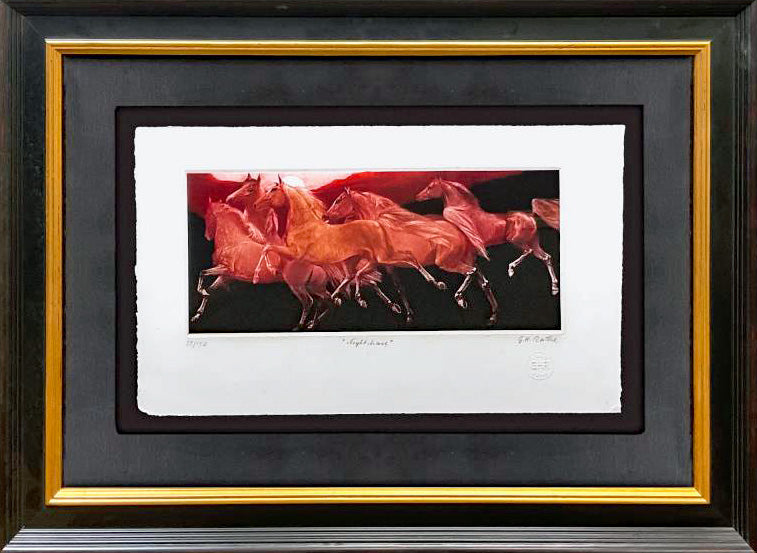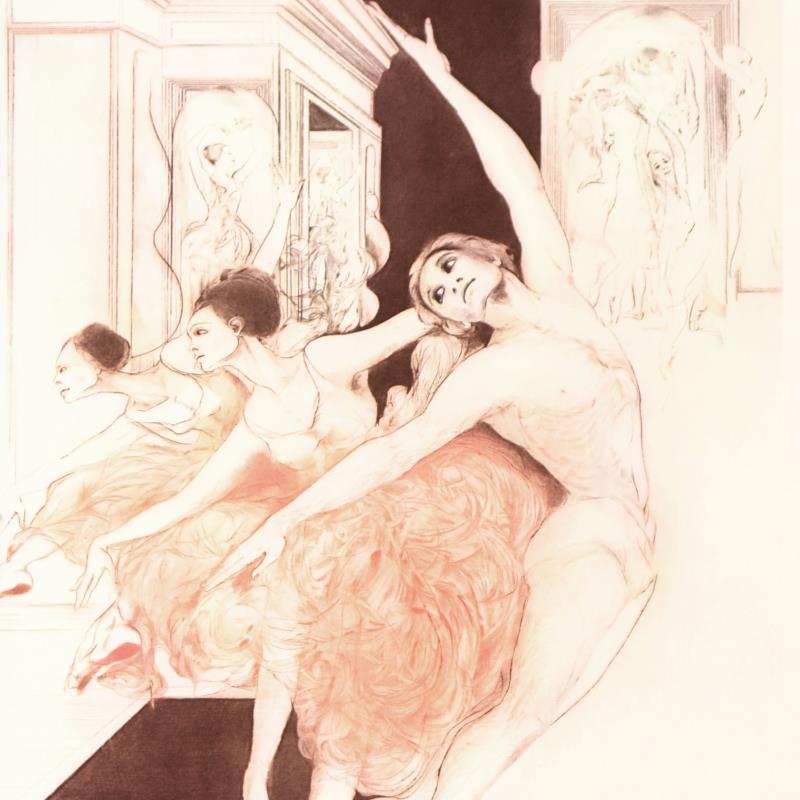G.H. Rothe (1935–2007) was a German-American artist known for her printmaking, especially mezzotint. She was born Gatja Helgart Rothe in Beuthen, Germany and grew up in Wiedenbrück, Germany. Following early training in drawing and goldsmithery, she studied painting at Pforzheim Academy of Design, Germany, where she was awarded the Villa Romana Prize, which enabled G.H. Rothe to live and work in Florence for a year. She was also a draftswoman and painter. After living and working in Europe, she briefly traveled through South America before moving to New York City in the 1970's and later, California. G.H. Rothe's commercial success was primarily based on mezzotints and paintings commissioned and handled by galleries, dealers, and private collectors in the United States, Europe and Japan such as Sylvester Stallone and Clint Eastwood.
G.H. Rothe's father served in the German army during WW II, while her mother left Beuthen with Riedel and her four brothers trying to find a way into West Germany. After more than a year of constant movement they finally settled in Wiedenbrück in 1947. These early years as a war refugee would have a profound impact on her artwork. Her father, who survived the war, was able to join the family in Wiedenbrück, where he reestablished his jewelry trade, building a goldsmith studio at their house and opening a jewelry store in town. Riedel became an apprentice in her father’s workshop. Assigned the task of drawing one flower every day, she began to develop her artistic skills and passion. In 1956, at age twenty-one, Riedel hitchhiked to southern Germany, where her brother was studying design at the art academy in Pforzheim. She enrolled in painting and drawing classes there and met her future husband, Curt Rothe, a painting professor and post-impressionist artist. Riedel became increasingly interested in this bohemian counterculture and in the estate’s atmosphere of freedom. In 1958 Riedel married Rothe, with an agreement that she could continue to pursue her career as an artist.
G.H. Rothe, while caring for her child and the estate, developed a body of work that explored the intimacies of bodies and what she called “anatomy landscapes.” She received her first solo show in 1967, exhibiting paintings of eccentric humanoid forms depicted inside boxes. In 1968 she was awarded the Villa Romana Prize for emerging German artists and traveled with her son to Florence. For the next year, she was provided with all the materials she needed, allowing her to develop her technique and artistic language, as well as her professional independence. During her stay in Florence, Rothe had a series of shows in Spain facilitated by a gallery owner and curator who eventually became her lover. They traveled from Barcelona to Montevideo on a cruise ship, leaving Rothe's son with his father at the estate in southern Germany. The couple then traveled in a van around South America for nine months, but Rothe’s lover fell ill and had to go back to Europe for treatment for his alcoholism. Rothe left Montevideo in 1971, following advice of an artist friend who suggested she moved to New York City.
G. H. Rothe began painting landscapes and skylines, and kept exploring her interest in bodies. In her early paintings in New York she began her explorations with layering, creating compositional narratives out of her experiences in the city. She started attending the ballet and expanded her interest in the body into studies of dancers in movement. A gallery owner and friend suggested that, if she wanted to earn a living from her artwork, it might be more efficient to create prints than paintings. As she delved into different printmaking techniques, Rothe became intrigued by mezzotint, which, while requiring a high level of skill and patience working by hand directly on the copper, permits the nuance of every line and detail to be seen. Combining the knowledge from her studies in anatomy, art history, goldsmithing, and drawing, she arrived at an original process that allowed her to achieve detailed transparencies with mezzotint. Another innovation was a method of applying and hand-wiping all colors on the same plate. Her first mezzotints with transparencies were completed in 1972 and soon garnered a lot of attention. A good friend in New York gave her the name Gatja, which she adopted in signing most of her work. Believing that people might taker her more seriously if they assumed she was a man, she then decided to use the initials G. H. and her last name. In 1973 her husband died and her son Peter moved in with her. At the time she was designing jewelry for Tiffany’s and other jewelers.
In 1976 G. H. Rothe signed a contract with Hammer Galleries in New York. She worked in a studio at 193 Second Avenue in Lower Manhattan. In 1978 she was listed in both Who’s Who in American Art and Who’s Who in America. In 1978 Rothe traveled to Los Angeles to visit her lover Maurie Symonds, who owned several galleries in California showing her work. Rothe became fascinated with Carmel-by-the-Sea, California and decided to move there, although she kept a storage space and a studio in New York. The open and rural California landscapes influenced her new mezzotints, in which she included mountains, horses and other scenes. In 1982 her son Peter bought her contract from Hammer Galleries, which no longer wanted to carry prints. The scandal caused by Salvador Dalí’s pre-signed papers had adversely affected the entire graphics industry, devaluing the worth of copies in editions.
G. H. Rothe survived this issue because not only did she limit her editions to 150, but also each print was unique, since she mixed all the colors on the plate by hand. Peter became the mediator between Rothe and the art market, giving her the space to further develop her technique. Throughout most of the 1980's and 90's, Rothe had about ten large shows each year in different US cities, and Peter regularly showed her work at the Basel Art Fair. Every month or two, she created a new edition for galleries to buy. She made all of her work with the help of one assistant.
G. H. Rothe also did paintings for private commissions, but she rarely kept track of these sales. Sylvester Stallone and Clint Eastwood, who were her neighbors in Carmel, both own some of her paintings. She painted a large outdoor mural in the Hog’s Breath Inn, Clint Eastwood’s former restaurant in Carmel. In 1987 Peter sold Rothe's art business to Paul Zueger from American Design. A year after in 1986, her brother opened Riedel Art Gallery to represent her work in Germany, and Rothe moved her New York studio from Manhattan to Brooklyn in order to have more space. She began exploring large pastel paintings and creating frescoes at her own home. Later, after a drawn-out lawsuit with Zueger, Rothe finalized her contract with them and opened her own gallery in Carmel in 1991. In 1988 and 1992 she was nominated to represent the United States as an artist at the Olympic Games in Seoul and Barcelona.
In 2000, after some tiresome lawsuits had finally been settled, G. H. Rothe decided to move to Geneva, Switzerland, fulfilling a desire to return to Europe. Here, she lived off the sale of her house in Carmel. In Geneva Rothe painted mountain landscapes, massive horse paintings, portraits, and other scenes inspired by her surroundings. In 2003 Rothe was diagnosed with breast cancer, but it was a heart problem that led to her death on August 3, 2007.

 Vendor:Night Chase - Limited Edition Mezzotint on Paper by G. H. Rothe (1935-2008)Art Deals
Vendor:Night Chase - Limited Edition Mezzotint on Paper by G. H. Rothe (1935-2008)Art Deals
 Vendor:Bolshoi - Limited Edition Printer Proof Serigraph on Paper by G. H. Rothe (1935-2008)Art Deals
Vendor:Bolshoi - Limited Edition Printer Proof Serigraph on Paper by G. H. Rothe (1935-2008)Art Deals





